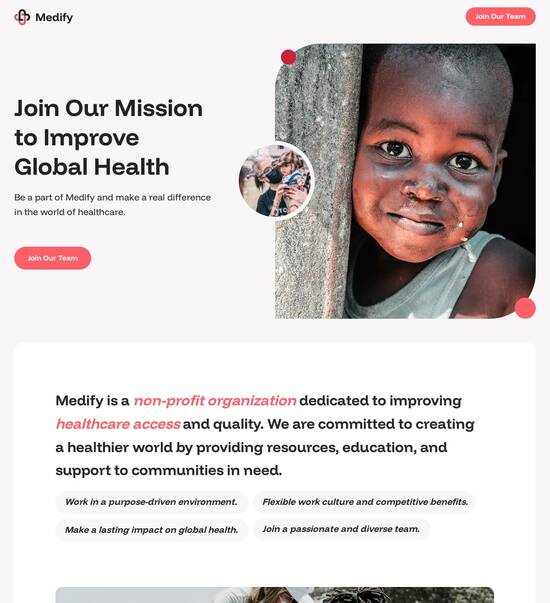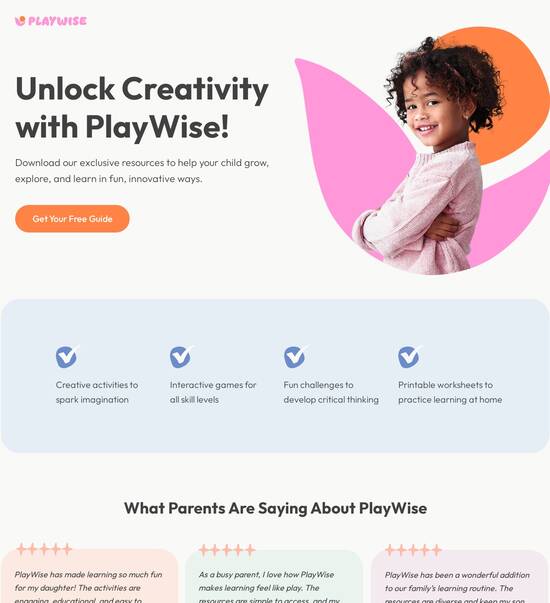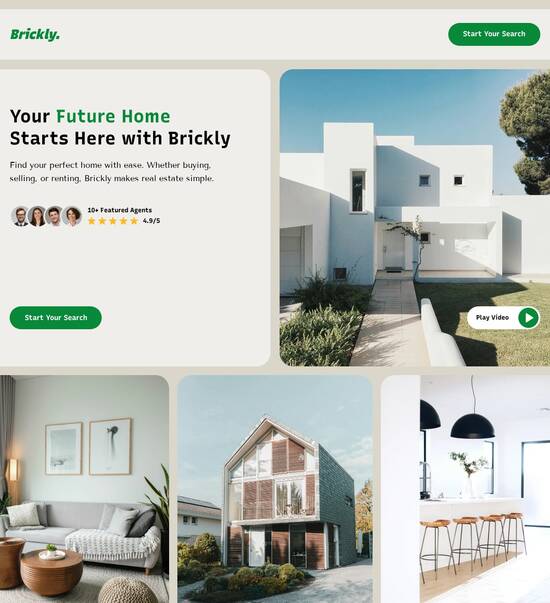
Next.js optimized conversion focused page template
Explore Similar TemplatesAbout template
Supercharge your conversion focused page with Next.js for outstanding performance! Learn more today.
Recommended templates

Easy to build without coding
With the intuitive drag-and-drop builder, anyone on your team can create high-converting pages without any knowledge of code or design. Make enhancements to your landing page with custom widgets using Javascript, HTML/CSS, or third-party scripts.

Multiple layouts for any industry and goal
Select from 500+ landing page layouts built to boost conversions across industry-specific scenarios. Customize them by adjusting fonts, adding images, and generating on-brand content with the AI assistant. Quickly scale with Instablocks® and Global Blocks that you can save, reuse, and update globally.

Loads fast and looks polished on any device
Every template is responsive, which means they present professionally on any device and load blazingly fast with our Thor Render Engine. You can also power them up with Google AMP technology to deliver an unparalleled mobile experience and drive higher conversions.

Robust analytics & experimentation
Get real-time updates and reporting across all your devices, showing the number of visitors, conversions, cost-per-visitor, and cost-per-lead. Launch AI-powered experiments, run A/B tests, and use heatmaps to analyze user behavior, then optimize your landing page to maximize conversions.







Easy to build without coding
With the intuitive drag-and-drop builder, anyone on your team can create high-converting pages without any knowledge of code or design. Make enhancements to your landing page with custom widgets using Javascript, HTML/CSS, or third-party scripts.
Multiple layouts for any industry and goal
Select from 500+ landing page layouts built to boost conversions across industry-specific scenarios. Customize them by adjusting fonts, adding images, and generating on-brand content with the AI assistant. Quickly scale with Instablocks® and Global Blocks that you can save, reuse, and update globally.
Loads fast and looks polished on any device
Every template is responsive, which means they present professionally on any device and load blazingly fast with our Thor Render Engine.
Robust analytics & experimentation
Get real-time updates and reporting across all your devices, showing the number of visitors, conversions, cost-per-visitor, and cost-per-lead. Launch AI-powered experiments, run A/B tests, and use heatmaps to analyze user behavior, then optimize your landing page to maximize conversions.
All the features you need to build lead-generating landing pages
Explore more featuresLearn how to build top-performing landing pages for any goal
FAQs
Leading the way in building high-performing landing pages





The ultimate guide to Instapage for conversion-focused landing pages
In today's fast-paced digital marketing landscape, having a robust landing page strategy is crucial for maximizing ROI. Instapage's powerful landing page and CRO platform offers a seamless solution designed for marketers seeking to enhance their campaigns. With features tailored for various sectors, including tech, education, and financial services, Instapage is positioned as the go-to tool for creating high-converting landing pages that cater to diverse audiences.
Why choose Instapage for landing page creation?
Instapage provides a unique blend of flexibility and functionality that makes it ideal for businesses of all sizes. By utilizing more than 100 conversion-focused templates and intuitive page-building tools, marketers can efficiently design landing pages without requiring coding skills. This approach allows teams to focus on optimizing ads and driving conversions.
- Templates: Instapage offers high-converting templates that are pre-built and customizable, enabling quick deployment of landing pages tailored to specific campaigns.
- Lead Generation Elements: Built-in lead generation features assist marketers in capturing leads more effectively, ensuring that potential customers are not lost during the process.
- Optimization Tools: With A/B testing and detailed analytics, Instapage empowers users to continually iterate on their landing pages for persistent improvement.
Steps to creating effective landing pages with Instapage
Creating a successful landing page with Instapage involves several steps that focus on design, optimization, and analysis. The process is interactive and user-friendly, allowing marketers to adapt pages based on performance metrics.
- Step 1 - Choose a Template: Start by selecting a template that aligns with your marketing goals, or create a unique design using Instablocks.
- Step 2 - Customize Your Page: Utilize drag-and-drop functionality to add elements that resonate with your audience, ensuring a personalized experience.
- Step 3 - Implement Optimization Strategies: Set up A/B testing and incorporate heatmaps to identify areas for improvement and refine your landing pages accordingly.
Analyzing performance to make data-driven decisions
Once your landing page is live, continuously monitor its performance to gather insights and make necessary adjustments. Instapage's analytics dashboard provides in-depth reporting that can help you understand user behavior and optimize for higher engagement.
- Utilize Heatmaps: Track where visitors click and scroll on your page to make informed adjustments to layout and content.
- A/B Testing Results: Regularly perform A/B tests to evaluate different versions and determine which resonates best with your audience.
- Setting Up Goals: Establish clear conversion goals and assess how well your landing page meets these, allowing you to focus on metrics that matter.
By following these methods, your landing pages can effectively capture leads and improve ROI. Instapage makes this process easy and efficient.
Investment in robust tools like Instapage is essential for marketers aiming to stay competitive in today's digital landscape. Their features not only streamline the landing page creation process but also ensure that user engagement is maximized.
Start transforming your digital marketing campaigns today with Instapage, and unlock the potential for increased conversions and higher ROI on your investment.
Next.js optimized conversion focused page template
Understanding the Next.js ecosystem for optimized conversion pages
Next.js has established itself as a powerful framework in modern web development, particularly for building optimized conversion-focused pages. This framework utilizes React, enabling developers to create dynamic web applications efficiently. The primary appeal of Next.js lies in its hybrid model that supports both server-side rendering (SSR) and static site generation (SSG). This flexibility allows developers to choose the right rendering strategy based on the needs of their web application, making it ideal for landing pages that aim to maximize conversion rates.
Both server-side rendering and static site generation enhance loading speed and SEO, which are crucial for capturing user attention. Fast load times can significantly reduce bounce rates, while improved SEO strategies can help your landing page rank higher in search results. In a competitive landscape, where user attention is limited, the design of conversion-focused pages becomes paramount to converting visitors into customers.
Combined benefits of server-side rendering and static site generation improve performance and SEO.
Flexibility to choose rendering strategies based on application needs.
Optimized page designs are crucial in enhancing user engagement and conversion rates.
Dissecting the anatomy of a conversion-focused page template
Creating a high-converting landing page requires an understanding of its essential elements. The headline serves as the first point of contact with your audience. Crafting a compelling narrative that draws users in can significantly impact engagement rates. The subheadline follows, providing supporting statements that reinforce the headline's message and encourage deeper exploration of your content.
Visuals play a crucial role in user engagement and can drastically affect conversion rates. Integrating high-quality images and videos enhances the user experience and helps communicate your message more effectively. Additionally, the placement and design of call-to-action (CTA) buttons should be strategically considered; they need to be easily noticeable and placed in intuitive locations. User testimonials can also enhance trust through social proof, providing potential customers with confidence in the value you offer.
Craft compelling narratives in headlines to capture attention.
Use supporting statements in the subheadline for reinforcement.
Incorporate images and videos strategically for better visual appeal.
Design prominent CTA buttons to ensure high visibility and intuitiveness.
Leverage testimonials to enhance credibility and trust.
Essential components of a Next.js landing page template
When developing a Next.js landing page template, creating a layout that fosters an intuitive user experience is vital. This involves structuring elements in a way that guides users naturally to information and the ultimate conversion point. Furthermore, incorporating interactive elements using React components can boost user engagement, allowing visitors to feel more involved with your content.
Ensuring responsiveness across devices is crucial in today's multi-device world. A well-designed template must adapt to varying screen sizes, maintaining usability without compromising aesthetics. Lastly, integrating SEO optimization techniques like metadata incorporation and schema markup will not only enhance visibility in search results but also provide critical information to search engines, thereby attracting more traffic to your landing page.
Create a user-friendly layout that promotes intuitive navigation.
Utilize React components for interactive and engaging content.
Ensure templates are responsive and compatible across devices.
Incorporate SEO techniques to enhance discoverability.
Crafting the perfect IndieHacker-inspired landing page
Key design principles can be drawn from the successful observation of indie startups. These often leverage unique visual storytelling methods to communicate their brand's value proposition. Templates inspired by the indie hacker ethos should reflect authenticity and user-centric features, presenting narratives that resonate with the community. It is also critical to focus on user experiences that showcase personal stories and real-world applications of products or services.
Incorporating storytelling elements in both the design and content enhances user engagement. Presenting relatable scenarios illustrates how your product addresses specific pain points, which builds a connection with your audience. A page template should focus on clarity and simplicity to boost user understanding while appealing to the emotions and values common among indie startups.
Utilize storytelling techniques to create relatable content.
Design elements reflect authenticity and emotional engagement.
Present value propositions clearly to connect with users.
Designing with intention: Best practices for startups
Identifying your target audience is a foundational step in designing any landing page template. Utilizing analytics tools can help gather insights about user demographics, preferences, and behaviors, informing design decisions that cater specifically to your audience. Crafting user personas can further refine this approach, ensuring messaging and visuals resonate with specific segments.
Implementing an A/B testing framework within your Next.js pages allows you to create experiments to compare different designs, layouts, or content variations. By utilizing Next.js routing capabilities, setting up various test versions is straightforward. Interpreting results from A/B tests will provide data-driven insights that can guide developments and improvements, ultimately refining your approach to conversion optimization.
Gather analytics to gain insights into your audience.
Develop user personas to tailor content and designs.
Use A/B testing to optimize page elements based on performance.
Leveraging visual design to enhance conversion rates
Visual design heavily influences user behavior and conversion rates. Understanding color theory and psychology can help in selecting palettes that evoke the desired emotional response from users. Colors can draw attention to specific elements such as calls-to-action or important messaging, making them a critical consideration in your template design. This emotional engagement can lead users to take desired actions more readily.
Typography also plays a significant role in readability and perception. The right font choices can enhance or detract from your message, impacting how users interact with your site. Selecting fonts that align with your brand while ensuring that they are easy to read across devices adds to the overall user experience. Additionally, carefully selected imagery should balance aesthetics with performance capabilities, as large image files can slow down load times.
Choose color palettes based on psychological effects to evoke emotions.
Select fonts that enhance readability while aligning with branding.
Optimize imagery to improve performance without sacrificing quality.
Performance optimization strategies for Next.js pages
Performance is paramount when it comes to landing page conversions. Utilizing the automatic static optimization features of Next.js can significantly enhance load speeds. This feature serves static files directly, which is faster than serving them through a server. Moreover, prioritizing critical rendering paths ensures essential content appears first, offering users a more fluid experience as they wait for additional resources to load.
Next.js also offers an Image component that simplifies image optimization. This component automatically serves appropriately sized and formatted images, helping to manage responsive images without requiring additional effort from developers. Reducing load times can be further achieved through code splitting practices. By chunking application code into smaller pieces, only the necessary components load up front, leading to faster initial load times and improved user experience.
Utilize automatic static optimization for faster content delivery.
Prioritize critical rendering paths to improve perceived performance.
Leverage the Next.js Image component for optimized image serving.
Implement code splitting to reduce initial load times.
Leveraging analytics to drive continuous improvement
Analytics play a crucial role in understanding user interactions on your landing page. Integrating robust analytics tools enables businesses to track user movements, clicks, and other behaviors, allowing for precise identification of drop-off points. By pinpointing where users lose interest or exit the page, adjustments can be made to enhance user flow and increase conversions.
Moreover, establishing feedback loops through user experiences and testing allows for a continual learning process. Leveraging this data helps in refining content, visuals, and functionalities to cater more effectively to user needs. Effectively utilizing analytics and user feedback can lead to significant improvements in conversion rates and overall user satisfaction.
Use analytics tools to track user interactions effectively.
Identify drop-off points to streamline user flow.
Establish feedback mechanisms to improve the landing page continually.
Future-proofing your landing page template
As businesses grow, their needs evolve, making scalability a crucial consideration when developing a landing page template. Designing templates that can adapt to new technologies or adaptation without needing a complete redesign is essential. This flexibility allows startups to pivot strategies seamlessly as market conditions change.
Staying ahead of design and UX innovations also plays a role in keeping landing pages relevant. Continuous monitoring of industry trends enables marketers and designers to adapt their approaches, ensuring that landing pages resonate well with users. Adjusting templates in response to changing user behaviors and preferences is vital in maintaining effectiveness and achieving sustainable growth.
Design templates with scalability for future business needs.
Monitor trends continually to keep landing pages relevant.
Adapt to changing user preferences and behaviors for sustained success.
Showcasing successful case studies and examples
Highlighting exemplary indie startups that effectively utilize Next.js for landing pages provides real-world evidence of the framework's capabilities. Many indie projects have embraced this technology, leading to significant improvements in conversion rates. By analyzing these successful case studies, we can uncover the strategies and elements that contributed to their achievements.
These case studies often reveal common themes, such as emphasis on authentic storytelling and personalized user experiences. The implementation of key design elements like trust signals and engaging content creates a solid foundation for high conversion potential. By studying these examples, marketers and developers can draw inspiration for their own landing page projects.
Learn from successful indie startups using Next.js effectively.
Identify common elements that lead to high conversion rates.
Analyze strategies that resonate with target audiences.
Final reflections on innovation in landing page development
The development of Next.js optimized conversion-focused page templates offers transformative potential for marketers and web developers alike. As competition increases, it is increasingly essential for businesses to invest in high-performing landing pages that not only attract users but convert them effectively. Embracing innovative practices and experimentation within landing page designs can lead to continuous improvement.
Designers are encouraged to explore various strategies and utilize data-driven insights to create landing pages that resonate with their target audience. The result will be not only enhanced conversion rates but also the establishment of brand trust and customer loyalty. As businesses evolve, so too must their approaches to landing page creation, ensuring they remain relevant and effective in meeting the needs of users.
Opt for Next.js to create high-performing landing pages.
Encourage experimentation to refine user engagement strategies.
Focus on continuous improvement to meet evolving user needs.
Ready to skyrocket conversions?
Supercharge your ad campaigns with high-performing landing pages
Get started














